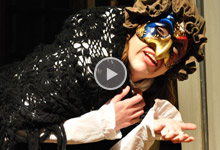
How did pantomime come to be the form of entertainment it is today? What is it that attracts us - young and old - to this bizarre medley of fairy tale, dance, jokes and song? And how did it become part of our Christmas traditions? Professor Jane Moody, Director of the Humanities Research Centre and Professor in the Department of English and Related Literature, takes us on a journey through pantomime's colourful history.
The story of pantomime is a tale of dragons and serpents. It features men dressed as women, and women masquerading as young men. Pantomime presents a tale of good and evil, where hope triumphs over adversity after danger and virtual despair. It has its roots in ancient Greece, and via Italy and France, insinuates itself into Britain. Pantomime's unique fusion of eccentricity, ambiguity and absurdity has much to tell us about our national identity. Christmas, for many of us, would not be Christmas without pantomime; and pantomime was the place we first discovered the magic of theatre.
Pantomime has become quintessentially British: as British as Earl Grey tea or a good Indian curry.
According to writer and caricaturist Max Beerbohm, pantomime is the only art form ever invented in England. It's a splendid witticism, albeit untrue. Pantomime has become quintessentially British: as British as Earl Grey tea or a good Indian curry.
Pantomime's history is a story of border crossings, as plots and performers slip across national, linguistic and cultural boundaries.
Improvisation in Italy - commedia dell’arte
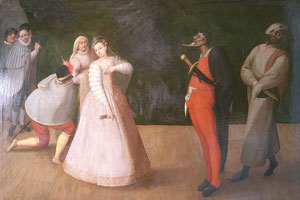
Our story begins with the commedia dell'arte tradition. The phrase means ‘comedy of the artists’ and these improvised performances took place outside in Italian streets and marketplaces. Commedia was a versatile, popular and influential art form.
Distinctive masks enabled audiences to recognise characters immediately; they also allowed actors to make topical and risqué jokes without fear of being recognised.
Travelling from place to place to earn their living, these actors began to take commedia across Europe. We know, for example, that these performers visited England on several occasions; British and European playwrights from Shakespeare and Lope de Vega to Moliere would all draw on commedia characters and traditions. Centuries later, commedia's stylised masks and anarchic energy shaped the visual and musical worlds of artists and composers from Prokofiev, Stravinsky, Braque and Picasso to David Hockney.
Key roles in the commedia
| Old men (the vecchi) | Young lovers (the inamorati) | Servants (the zanni) |
|---|---|---|
| The vecchi are doctors, scholars, military men and in commedia they are usually portrayed as cowardly, disreputable characters. Dottore sells fake medicines; Pantalone is an old man who vainly pursues younger women; and Capitano is a pompous coward with a spurious war record. | Their parents refuse to let them marry. Usually the father wants his daughter to wed a rich elderly man whom she despises. One of commedia’s legacies to pantomime is this archetypal clash of desires. So the lovers have to find a way of outwitting their parents—or later of defeating the baddie—to live happily ever after. | The fat clever Pulchinella is the forefather of Mr Punch in Punch and Judy shows; the sly amoral Arlecchino will later become the magical English Harlequin. Often hungry, usually broke, these characters represent the common people. The zannis are full of cunning, ingenuity, and quick-wittedness. |
Many commedia plots show the zanni outwitting the vecchi or overthrowing their masters. Their lives are a constant struggle to find food and money. They tell a story about survival against the odds. Survival in the face of cruelty and corruption.
What British pantomime will learn from commedia is the fun of witnessing the triumph of the underdog.
From the streets of Italy to the theatres of 18th century Britain
Think of the combined power of television and the internet and you start to understand the theatre’s reach and influence in the 18th century
So how did pantomime work its way into British theatre? Think of the combined power of television and the internet and you start to understand the theatre’s reach and influence in the 18th century. Thousands of people, from aristocrats to apprentices, patronised theatres in London every night; by mid-century, theatres were being built in towns and cities across Britain. Theatre was the place where everyone came to be entertained; and many of the plays spectators enjoyed were stories about what it meant to be British.
A rough, uneducated man called John Rich played a key role in the emergence of pantomime. Rich was a dancer, acrobat and mime artist and during the 1720s he was managing a theatre at Lincoln's Inn Fields. What he created was a new kind of entertainment. It combined a storyline from Ovid’s Metamorphoses and a harlequinade. This took the form of an energetic chase, featuring the adventures of Harlequin and Columbine, the commedia servants.
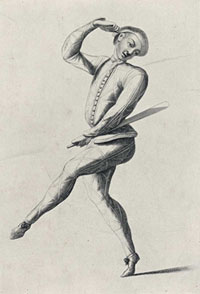
Harlequinades were tremendous fun to watch. Amazing transformations happened at the touch of Harlequin’s magic wand, with mechanical serpents and flying vehicles. Rich also introduced animal roles: dragons, ostriches, dogs and camels. Pantomime has always been fascinated by the crossing or transgression of boundaries: the pleasurable ambiguity of men dressed up as women, and the fun of animals played by human beings.
Rich’s pantomimes cleverly fused commedia, spectacle, music, ballet and myth. Like the commedia's Arlecchino, this Harlequin displayed extraordinary physical agility, and elemental desires for food, drink and sex. But unlike Arlecchino, the first English Harlequins did not speak.
Causing controversy and cashing in on a craze
Rich’s spectacular performances attracted huge controversy. Critics bitterly attacked pantomimes, complaining that this foreign entertainment threatened the downfall of Shakespeare and the death of serious theatre.
David Garrick, the great 18th century actor-manager, was quick to join these critical blasts against his theatrical rival. But he also realized the commercial potential of this emerging form. "If they won’t come to Lear and Hamlet", he said, "I must give them Harlequin".
But how could Garrick cash in on the craze and still maintain his position as the defender of 'legitimate' theatre? His tactic was to set about changing pantomime’s cultural identity, partly by limiting Drury Lane pantomimes to the Christmas season. Pantomimes became associated with the fun and frivolity of the holiday season rather than being denounced as a threat. In doing so, of course, Garrick created a convention which has survived to this day.
The clown: Joseph Grimaldi
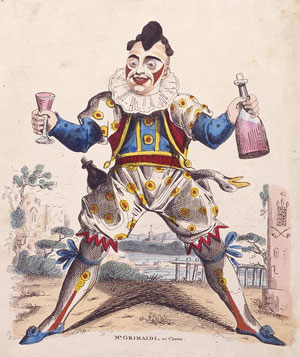
We now reach the end of the 18th century; the moment when the modern Clown really arrives. Joseph Grimaldi, the inventor of pantomime's most famous gags: the butter slide (when a character suddenly slips on the doorstep); sausages which suddenly come to life. Grimaldi, the singer of bizarre nonsense songs and the clown of urban life.
It’s the age of Regency: Britain is at war with France; there’s intense social unrest and violent confrontations between the government and the people. Again, pantomime seems to embody the spirit of the age, this time in more political terms.
The Clown is changing out of all recognition. Out goes the old costume, and the Clown’s familiar role as a stupid, loutish feed for Harlequin's magic. In comes a character with white face and red cheeks; a pie-crust frill and baggy trousers; a cavernous mouth, and an elastic, intensely expressive face. At a time of war, Grimaldi’s hilarious antics embodied the freedom and liberty of British culture by contrast with our dull, humourless despotic enemies, the French. Button’s comic routines and the Dame’s glorious absurdity have their theatrical roots in Grimaldi’s clown.
Grimaldi became one of the most famous characters in Regency London. Apprentices, merchants and aristocrats were all fascinated by him. Lord Byron gave him a snuff box; Charles Dickens paid tribute by compiling Grimaldi’s biography. Spectators rushed to the box office and crammed themselves into theatres to enjoy his latest show.
The Clown's anarchic activities included imprisoning policemen; tripping up old women; and constructing mock vehicles, from cheeses and odd bits of furniture, not to mention stealing trays of tarts and consuming gigantic quantities of sausages. But the Regency Clown never ends up in gaol. Audiences were thrilled by his mischief and his endless eating precisely because he created on stage the fantasy of a different world: a world without hunger, a world of comic revenge against a highly repressive government.
Grimaldi became one of the great satirists of his age, a Clown who offered ludicrous commentaries on fashion, technology, new forms of transport, and political authority as well.
Behind the clown - the real Joseph Grimaldi
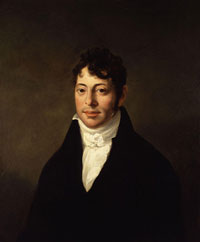
Beneath the manic, shameless energy of this Clown lay sadness, and a life etched by tragedy. Born into an immigrant family, Grimaldi was on stage before he was three, and the family breadwinner seven years later. He was a melancholy man who suffered paralysing periods of hereditary madness.
Perhaps that sadness was what attracted him, both in costume and in temperament, to Pierrot, the broken-hearted French Clown. Certainly Grimaldi liked to play on this mixture of light and darkness in his character, telling his audiences, ‘I am Grim all day, but I make you laugh at night’. It was not long before the grimness started to take over.
The amazing leaps and pratfalls he performed forced Grimaldi into premature retirement, destitution and an early death. Thousands of people would line the streets as his coffin made its way up to Pentonville Hill.
Into the Victoria age - Dan Leno and the Pantomime Dame
At the end of the 19th century, Britain is now a major imperial power. Photography has arrived, the telegraph has just been invented, the first motor cars are starting to appear on British streets. How has pantomime changed?
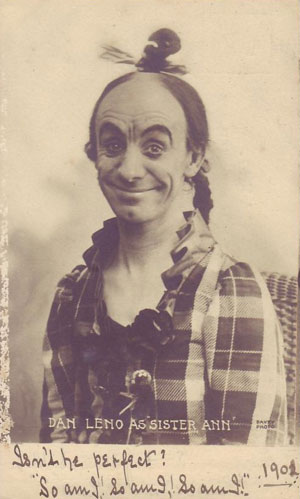
The centre of comic gravity is certainly shifting: away from the Clown and toward an unexpected star: a careworn mother, haggard and a bit of a gossip, struggling to cope in this unfriendly world. Pantomime crystallises around the story of a dysfunctional family and that strange, eccentric figure of the Dame. Dan Leno was the celebrated music-hall performer who created this garrulous, working-class woman.
So how did the Pantomime Dame come into being and why do we continue to be fascinated by this bizarre, eccentric figure?
Dames had existed in pantomime before Leno, but they were usually unbelievable, ridiculous characters. In the 1880s, Leno started playing roles like the Queen in Humpty Dumpty, or Widow Twankey in Aladdin. Slowly, he began to domesticate the Dame and to imagine her as a mother, facing problems which he and his audiences knew all too well: poverty, unemployment and abandonment. From humble beginnings, Leno himself had risen to fame as a clog dancer and variety artist. A small thin man, with an odd wistful face, and a husky voice, he was said to have 'the saddest eyes in the world'. What he brought to the Dame was a talent for impersonating the absurd dilemmas of ordinary people, from waiters and railway guards to downtrodden women. What emerged was a lovelorn older woman, facing adversity with a kind of desperate fun.
The woman who everyone knows is being played by a man
The audience and the character comically share the knowledge that the Dame is not really a woman; that the Principal Boy is not really a Boy
The strange key to Leno's success - and to the character of the Dame ever since - was his creation of a credible woman whom everyone knows is being played by a man. Performance has always exploited the pleasurable ambiguities of cross-dressing. But what distinguishes gender-bending in pantomime is the mock-seriousness which emerges in Victorian burlesque theatre. The audience and the character comically share the knowledge that the Dame is not really a woman; that the Principal Boy is not really a Boy. Pantomime's absurdity depends on us enjoying this non-existent pretence. Pantomime self-consciously disorganises the ordinary world and releases us to participate in its magic.
Leno created a Dame whose theatrical power comes from the locking together of our sympathy and our laughter. His women were intensely human characters, living in a chaotic world full of disastrous mishaps. In Humpty Dumpty, Leno played a debt-ridden Queen who is running out of lunch options: the cook baldly declares that she’s donated not just the cold beef but the King’s brace of pheasants, the fish and the pickled pork all to the royal cat. Audiences loved this hilarious piece of quickfire patter which ended with the Queen’s exquisitely logical solution, "well: there's only one thing we can eat. Serve up the cat for lunch."
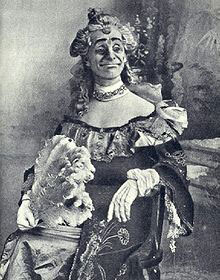
Leno’s Dames, played with an evocative Irish lilt, were down to characters. They spoke in a form of inconsequential chatter. This cleverly captured the rhythms of ordinary speech, while opening up chasms of lunacy, one absurdity on top of another.
Just like Lewis Carroll and Edward Lear, Leno revelled in the ludicrous logic of nonsense.
So Leno’s Dame is taking the starring role from the Regency clown. The harlequinade has mysteriously disappeared, a casualty of respectability. For the Victorian middle classes, watching policemen being beaten up is no longer a form of entertainment. But at the same time, music hall artists such as Leno were infusing pantomime with the plots and dilemmas of working-class culture. With some of these celebrities came a more raucous, bawdy and suggestive edge.
Pantomime today
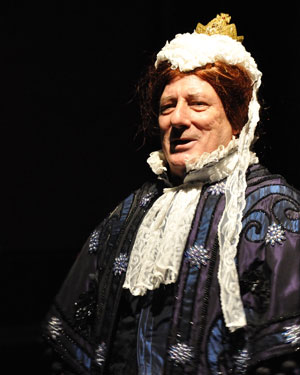
Across the UK, children and adults come to their local theatre to be dazzled and thrilled by the spectacle and the fun of pantomime.
In York, the pantomime has been an extraordinary success story, the jewel in the city's entertainment crown. Each year 55,000 people of all ages come to the York Theatre Royal to see a cast headed by Berwick Kaler (right) who has played the dame for more than 30 years. Pantomime has become a major visitor attraction in its own right.
Not to like pantomime, the journalist Leigh Hunt declared, is not to like love: pantomime is a curious blend of continental and British traditions. The raw energy of music hall, the sauciness of Victorian burlesque, the crazy chase of the harlequinade, the acrobatic power of John Rich, the archetypal plots of commedia. All these elements have shaped the pantomimes we enjoy today. The story of pantomime is a story of transformation and endless adaptation.
Our delight in this form comes from a complex mixture of emotions and relationships. Pantomime offers us the anarchic excitements of a topsy-turvy world only to give us the assurance of harmony restored. The Dame’s absurdly captivating character is the great legacy to modern pantomime left by a remarkable artist of the Victorian music hall. It was Leno who introduced into the traditional quest narratives of Humpty Dumpty and Aladdin a deeply human figure who has since become one of the most eccentric character in British culture.
The Dame exemplifies pantomime's self-proclaimed absurdity. Her comic patter with the audience cuts across the boundaries between performers and spectators, drawing us into her chaotic world. She presides over the anarchy which Grimaldi once visited on policemen. But the Dame also embodies the collective ties which bind us together as families, as neighbours, and as citizens of a particular town or city.
Further information
- This feature was based on "Pantomime before Berwick Kaler", a Merchant Adventurers' Arts Discovery Event held on 9 November 2010.
- Professor Jane Moody is Director of the Humanities Research Centre and Professor in the Department of English and Related Literature.

